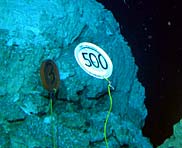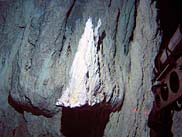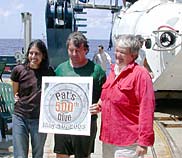|
|
|||||||||||||||||||||||||||||||||||||||||||||||||||||||||||||||||||||||||||||||||||||||||||||||||||||
 |
|||||||||||||||||||||||||||||||||||||||||||||||||||||||||||||||||||||||||||||||||||||||||||||||||||||
Today's journal is a tribute to Pat Hickey and his 500th Alvin dive—Thank you, Pat, from all of us! Dive 3881 today was special, not only because this was our farewell dive in the Lost City Hydrothermal Field, but, more importantly because it marked the 500th dive that Expedition Leader Pat Hickey has made to the seafloor in Alvin.
The dive started like most at the end of a long series—final dives are commonly some of the most difficult because their main goals usually include a multitude of diverse “chores” that have some how accumulated at the end of the program.
This last dive was no different and entailed a long wish list of things that people wanted (short explorations of new venting sites, rocks from specific areas, co-registered suites of fluids, biology and carbonate samples from multiple places, mosaics of entire structures to obtain full-view images, and finally traverses around the outer edges of the huge structure Poseidon). The wish list for this one was long and there were many places we needed to visit. By 7:40 on this sunny, calm morning, Pat in his quiet, efficient manner had worked through the dive checklist. He made a few jokes with bleary-eyed well-wishers who had stayed up until 3 am in the morning to watch the lunar eclipse. Typical of Pat, he never let on that this was to be his 500th dive, even though it is a remarkable achievement. He acted like it was just any other dive. But it was not.
Perhaps one way to put his outstanding accomplishment into perspective is to note that only one other Alvin pilot has ever dove 500 times in the nearly 40 years that Alvin has been in operation. As Expedition Leader he has trained numerous pilots and he has been instrumental in keeping the sub updated as new technologies and equipment become available. During this last dive, we were lucky to have Pat as our guide. He is a consummate pilot who has an uncanny ability to know where the submarine is at all times and how to get to places, even if he has no navigation and has only been to a place once. His skills in the submarine are unmatched and because of his experience, he routinely leads scientists to the best sampling sites. Pat is also a generous teacher and he commonly goes out of his way to help new divers become acquainted with the do’s and don’ts in Alvin.
On this particular dive he showed Mausmi Mehta how to operate the cameras and talked with her about the controls that are used to “drive” the submarine. By the end of the dive, all items on our wish list had been checked off. We had a basket-load of samples from the Lost City Field, and spectacular video and still images of the hydrothermal chimneys. Alvin released weights and rose to the surface. On deck, the entire science party and crew turned out to greet Pat as he exited the sub. In the fine tradition of Alvin pilots, he was given a multiple bucket shower of ice water. Pat, many, many people have benefited from your help, generosity and fine piloting…we all thank you and look forward to your next 500 dives. |
|||||||||||||||||||||||||||||||||||||||||||||||||||||||||||||||||||||||||||||||||||||||||||||||||||||





